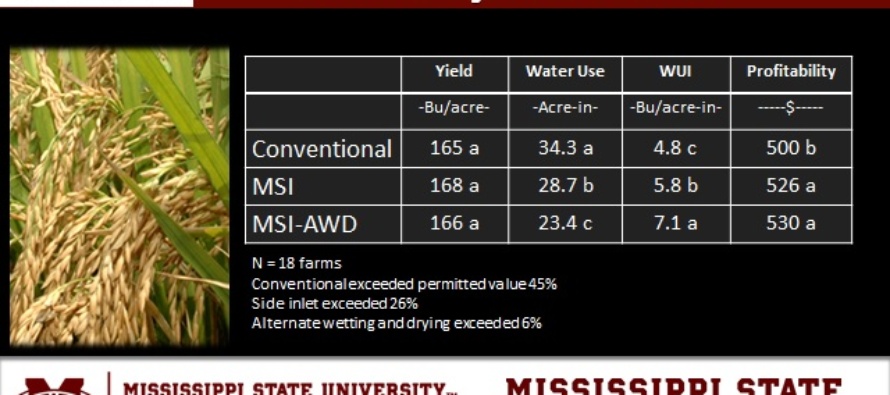Three Years of AWD Water Savings in Rice

Related Articles
- 2010 Row Crop Short Course Video Links 0
- Calcium and Magnesium For Mississippi Crops 1
- March 11 Precision Agriculture Workshop 0
Latest Tweets
AWD is a water -saving technology that farmers can use to reduce the amount of irrigation water used in rice fields without any yield penalty. In AWD, farmers allow the flood water to recede to a “muddy” state before re-flooding the field. The number of days of non-flooded soil between irrigations can vary from 1 day to more than 5 days depending on soil type, weather and crop growth stage. This process lowers the total time pumping in addition to capturing rainfall.
-saving technology that farmers can use to reduce the amount of irrigation water used in rice fields without any yield penalty. In AWD, farmers allow the flood water to recede to a “muddy” state before re-flooding the field. The number of days of non-flooded soil between irrigations can vary from 1 day to more than 5 days depending on soil type, weather and crop growth stage. This process lowers the total time pumping in addition to capturing rainfall.
Since 2014, the MSU Irrigation team has implemented eighteen farmer “on farm” AWD irrigation trials. Each farmer agreed to irrigate his field conventionally through levee gates, via multiple inlet, and an additional multiple inlet field utilizing AWD. The farmer initiated irrigation on the conventional and multiple inlet fields, while the MSU researcher scheduled irrigation on the multiple inlet, AWD field. The MSU researcher allowed the field to drain to a muddy state utilizing a Pani pipe to assist his observations before making the decision to irrigate. Having the Pani pipe installed in the field allowed the researcher to monitor the water level to 4″ below the soil surface. Weather forecast were also utilized in the decision making process. The conventional and multiple inlet fields held “at capacity” or a 4″ flood permitted rainfall events to become runoff. Utilizing AWD, allowed for capture of rainfall events.
Results from the 2014-2016 trails are summarized below. Included are the yield and water use data for each grower location as well as an average of all data. The fields irrigated with conventional levee gates had an average water use of 34.3 acre inches. The use of multiple inlet reduced water use by 5.6 acre inches with an average of 28.7 acre inches used. Through the use of AWD, we were able to further reduce water use by an average of 10.9 acre inches over the conventional fields. This resulted in an average water savings of $30 per acre over the conventional irrigated field. Our on-farm data indicate that multiple-inlet, AWD maintains yield potential of conventionally irrigated systems while significantly reducing water use. These results should give farmers to confidence in the water saving Best Management Practices (BMP) that farmers can implement on their individual farms.





Let me tell You a sad story ! There are no comments yet, but You can be first one to comment this article.
Write a comment